|
We pick cotton like we did a hundred years ago and
we chop cotton like we did a hundred years ago, with
the exception that we put it into a sack now where we
used to put it in a basket.
-Fred Roberts, president, South Texas Cotton Growers
Association, 1920.
|
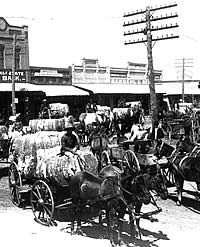
Cotton wagons on their way from the
gin to the cotton yard in Elgin. Photo courtesy of Leo
Foehner, Institute of Texan Cultures, University of
Texas at San Antonio. (Click to enlarge photo.)
|
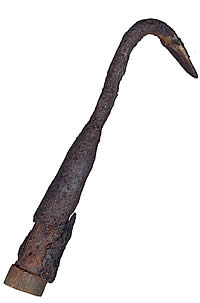
Hoe found during excavations at the
Osborn tenant house.
|
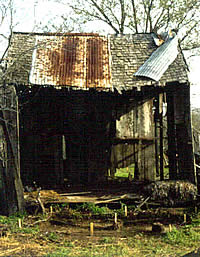
Tenant families lived in one of four
houses on the Osborn farm during the heyday of cotton
farming there in the early to mid-twentieth century.
This house, shown shortly before its demolition in 1987,
was excavated by TxDOT archeologists. (Click to enlarge.)
|
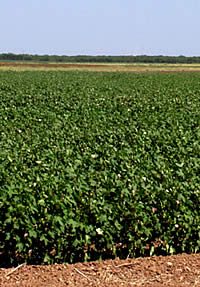
Rows and rows of cotton stretch far
into the distance. Tenant farmers on the Osborn farm
planted in "halves": five rows for their family,
and five for the owner. Between 90 and 100 acres of
the total 327 acres on the farm typically were planted
in crops.
|
|
So at the end of the year, you pay the boss man
and you pay anybody else you owe… And my daddy
would say that money left his hands sore. He said, "So
much money went through my hands, that that's all I
have left, sore hands."
- Pete Martínez, Jr.
|
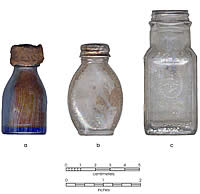
Samples of ca. 1930-1940s bottles
recovered during excavations at the tenant house. a,
"Vicks-Va-Tro-Nol 24" nose drops; b, "Bayer"
aspirin; c, "Gebhardt Eagle" chili powder.
|
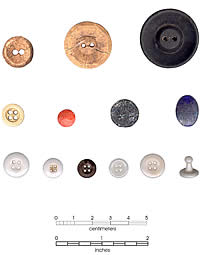
Buttons for every occasion were recovered
from the tenant house and yard. Most date to the early
part of the twentieth century. a-c are celluloid buttons;
d-g, plastic (probably dating to 1945; h-l, glass; m,
collar stud. (Click to enlarge.)
|
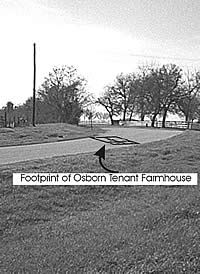
Today, nothing remains of the Osborn
tenant house. In this present-day view, the approximate
"footprint" of the house has been drawn over
a photo of the new road, Lovers Lane.
|
|
Cotton farming was vital to the industrial development
of Texas, and in Bastrop County it was one of the more lucrative
industries. But before the advent of mechanized harvesting,
it required hard, grinding labor to bring in a cotton crop.
Between 1840 and 1865, the work fell on the available pool
of African-American slaves. But after Emancipation and the
abolishment of slavery in 1865, cotton growers turned to tenant
farming as a means of securing the needed labor. The tenant
system was popular throughout the latter part of the nineteenth
century and into the first-half of the twentieth century.
In many instances, as was the case with T. C. Osborn, the
owner lived in town and allowed the tenant farmers to live
on and work the farm with little or no supervision.
During the late-nineteenth century, many of
the tenant farmers were former slaves, but in time many of
these workers left for better jobs in the developing cities.
This migration of farm workers and the growing demands of
the cotton industry caused a labor shortage that had to be
replenished.
At the turn-of-the-century, a reserve of low-paid
Mexican labor existed across the border and was an important
factor in the development of large-scale agriculture in south
and central Texas. Mexicans came by the thousands to work
on farms at wages of about $1.00 per day. In most cases, the
economic advantages afforded by employment in the U.S. pulled
Mexicans across the border, just as the violence and economic
disorder caused by the Mexican Revolution pushed them out
of Mexico.
Throughout the 1920s and well into the post-World
War II years, this large pool of agricultural workers made
cotton the premiere industry Texas, and the Mexican workers
the laborers of choice. Their labor was critical, because
modernization was slow in coming to the cotton fields. As
noted in 1920 by Fred Roberts, cotton farmer and president
of the South Texas Cotton Growers Association:
Modern machinery…has made it possible
for one man to cultivate a great deal of land, but there
has been no development along the line of picking and chopping
cotton. We pick cotton like we did a hundred years ago and
we chop cotton like we did a hundred years ago, with the
exception that we put it into a sack now where we used to
put it in a basket.
By 1920, 55% of all Bastrop County farms were
tended by tenant farmers, many of them Mexican Americans,
and the remainder by owner-operators. Within this system,
there were two types of tenant farmers: share tenants and
sharecroppers. The share tenant rented land and a house from
farm owners, and then cultivated with his own seed, equipment,
horses or mules, and made use of his family's labor. In contrast,
sharecroppers were resident laborers who were given a house
by the owner and received monthly cash advances to tide the
family over until the end of the season. Most sharecropper
agreements were for either halves or quarters. In Bastrop
County, most sharecroppers worked for halves.
As explained by Pete Martínez, Jr., a
former resident of the T. C. Osborn farm:
The way my daddy did it—all the time
I knew him, from the time I was born until the time he quit—the
landlord provided the land, the seed, and the mules and
plows. He furnished everything. The only thing you furnished
was your work. You and your family got out there and worked
for him.... When you go to harvesting the crop, you pick
a bale of cotton, you put it in the wagon, you bring it
to the gin, they'll gin it for you, they'll tell you how
much it brought you, you take that check to the landlord,
you get half of it.
See, you have to come up with quite a few
bales before you can get anything out of it, because all
during the year the landlord, he's advancing you money.
They had a deal where, depending on the size of the family,
they'd give you so much per month. And on the first of the
month you'd go up there and get your money.
Martínez recalled that the amount of
the monthly allowance was about $20. "Of course money
was different then," he said. "It was hard to get,
but it went a long way." Today, he continued, it's easy
to get, but it but it doesn't go very far.
His father-in-law, José Barrón,
sharecropped land near the Osborn farm. Barrón recalled
that his entire family, including his three brothers and three
sisters, pitched in to help on the farm whenever they could.
Their father was the planter, or sembrador, and the
children provided the labor during the harvest—piscaban
la cosecha.
In most families, children were taught to do
chores and hold small jobs early on out of necessity. Mrs.
Louise Rodríguez García recalls that she and
her four sisters helped in the fields from the time they were
five years old. She and her husband, David García,
and their children lived in the small Osborn tenant house
from about 1932 to 1941.
According to her daughter, Emma García
Rockwell, few sharecroppers could afford to hire people. Most
had to use the immediate family. People would get paid depending
on the amount, or weight, of the cotton picked.
If you had a bountiful crop, you might hire
people then, she said, but she couldn't recall her father
ever having hired outside help. "We, the families, had
to do it in order to keep the money within." She remembers
going into the fields by the time she was around seven or
eight years old, and she also took small jobs to help the
family make ends meet.
I went to school, but then I had to come
and help after school. Mother, like my grandmother, made
the clothes for us. My dresses cost 25 cents—2 ½
yards at 10 cents a yard. But 25 cents were not easily available.
I recall that canned milk was a must for my brother, Homer,
a baby in 1942. So I found a job washing dishes for a lady
who paid me 50 cents a week. I did this work en route to
school. It only involved about 30 minutes. The pay covered
the cost of the milk: 12 cans at 4 cents each.
The family had a milk cow and chickens and
also grew corn to supplement their needs. Mrs. Rockwell continued
helping in the fields for as long as her father had the farm
(ca. 1941). She was the first Latina to attend what
had previously been an all-Anglo high school and, after graduation,
she worked at nearby Camp Swift to earn enough money to attend
Southwest Texas State University. She eventually went into
the U.S. Foreign Service and worked in various embassies in
Europe and Central America.
The older generation, however, often found themselves
bound by the system, according to Pete Martínez, Jr.:
You see that's all the Mexican people did.
That's all they knew. You just got by. And you bought things—it
was just on a handshake back then. So at the end of the
year you pay the boss man and you pay anybody else you owe....
And my daddy would say that money left his hands sore. He
said so much money went through his hands, that's all they
have left, sore hands.
In spite of the hardships and hand-to-mouth
nature of the system, most sharecropper families showed a
strong work ethic, pride, and optimism. Martínez recalled
that his father's uncle, another farmer, was always a happy
man. He would say, 'Well, I don't have anything left, but
I've got my doors open.'"
See, what he's saying is that he paid
everybody, so he can go back and start charging from them
tomorrow if he wants to, because you see, his name was good.
He made good on that money he owed. See, that was the deal,
when my crop comes in, I will pay you. And they did.
Martínez's father moved off the Osborn
farm in 1954 after his son went to Korea. His uncles, the
Domínguez brothers, were the last persons in Bastrop
to sharecrop, finally quitting the system in the late-1950s
or early-1960s.
|
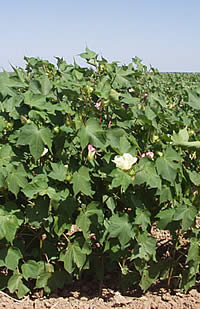
Cotton plants, shown in bloom in
late summer, typically are ready for harvest in fall.
Click images to enlarge
|
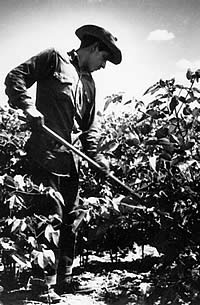
Weeding rows of cotton near El Paso
along U.S. 80. Photo courtesy of TxDOT and the Institute
of Texan Cultures, University of Texas at San Antonio.
|
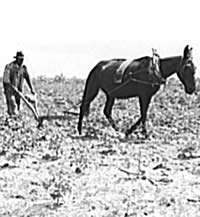
Farms were worked mostly by hand
and with mule-drawn plows until the later half of the
twentieth century when mechanized equipment became widely
used. Photo courtesy Institute of Texan Cultures, University
of Texas at San Antonio.
|
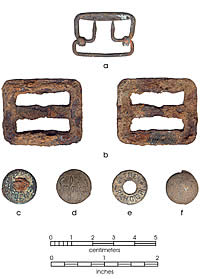
Metal suspender clasps and buttons
found in the tenant house excavations are reminders
of the heavy field clothing worn by the cotton farmers.
(Click to enlarge.)
|
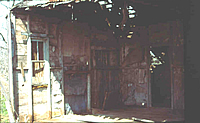
In a state of dismal disarray, the
Osborn tenant house awaits demolition. (Click to enlarge.)
|
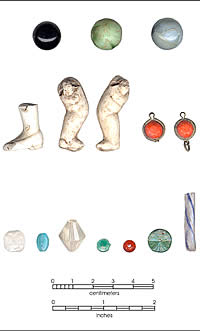
Children's toys and decorative beads,
recovered in the tenant house, are poignant symbols
of the pleasant family life recalled by several former
residents.
|
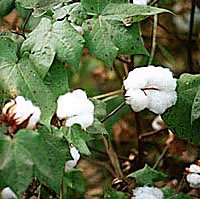
Cotton bolls, ready to harvest.
Photo by Mary G. Ramos, courtesy Texas Almanac.
|
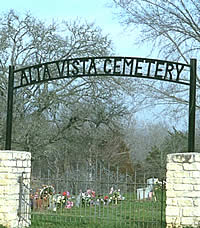
Alta Vista cemetery in Bastrop, where
many of the Osborn tenants were buried. |

Cows graze where cotton once grew.
After tenant farming operations ceased in the 1950s,
much of the Osborn land was leased as pasturage for
cattle. Photo courtesy Ann Fellows Murphy.
|
|